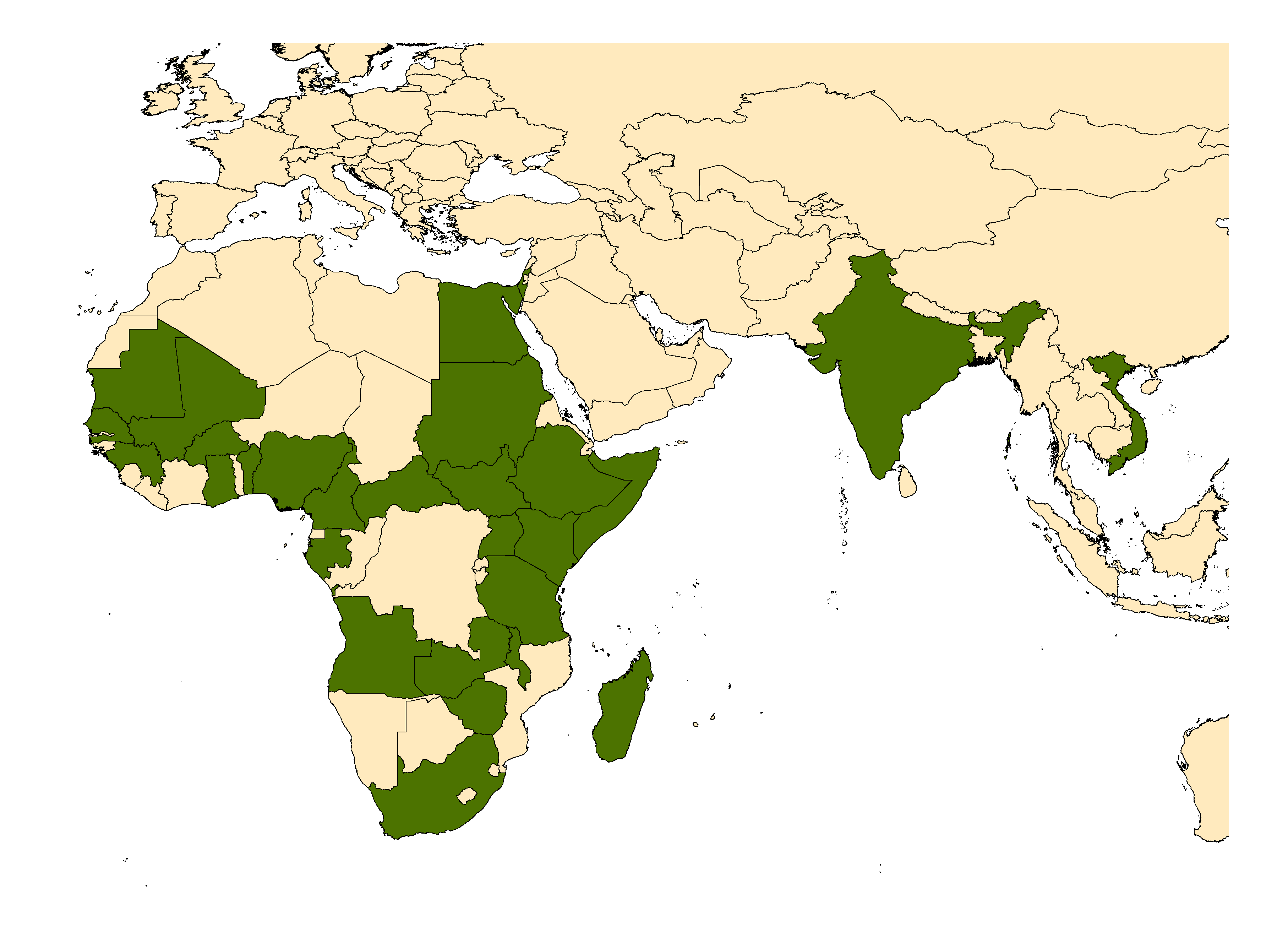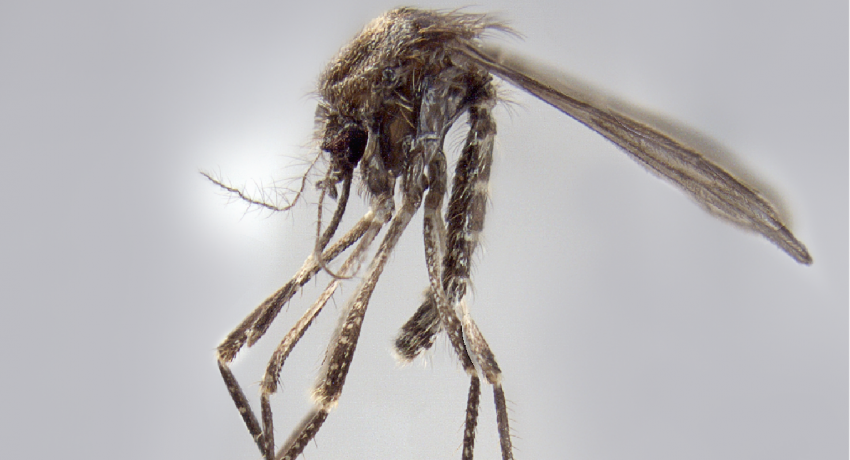AFROTROPICAL REGION
Informal name: Sock Nigerian Typical Mosquito [poicilipes = “spot hair footed” = woolly sock]
Etymology: not stated [spotted hair footed (Gr); (possibly refers to leg markings)]
Culex poicilipes is unplaced within the subgenus Oculeomyia. It is a large, dark species, readily recognized by the attractive rows of pale spots that adorn its femora and tibiae, and the distinct median pale band on its proboscis.
Type locality: Bonny, [Eastern Provinces], Nigeria
Type depository: Natural History Museum, London, England, United Kingdom (NHMUK)
DIAGNOSTIC CHARACTERS (Click photos to view; mouse over and click large photo to zoom in.)
ADULT (illustrated): Head: Proboscis with median pale band. Thorax: Lower proepisternal scales present; mesepimeral setae absent. Wing: Dark-scaled. Legs: Fe-I–III and Ti-I–III with rows of pale spots anteriorly; Ti-II without pale stripe; Ta-I–III with narrow basal pale rings. Abdomen: Seta 7-I about as long as 6-I, usually single.
LARVA (not illustrated): Head: Dorsal apotome distinctly separated from median labral plate; seta 1-C stout, thicker than branches of setae 5,6-C; seta 14-C single. Terminal segments: Comb with ≤10 comb scales; comb scales spine-like, with pointed apex and proximal fringe; siphon curved in lateral view; pecten with pecten spines on basal third of siphon; seta 1-S 2.5–3.0 x width of siphon.
TAXONOMIC KEYS
Ribeiro & da Cunha Ramos 1980
Harbach 1988
Jupp 1996
Exemplar DNA sequences
None
BIONOMICS
Immatures
Immature Cx. poicilipes occupy clean fresh water sites—lakes, swamps, marshy depressions near rivers, mature rice fields—with abundant emergent or floating vegetation, especially reeds, Pistia and Ceratophyllum. Larvae tend to stay deep in the larval habitat, respiring through air-bubbles 60 to 120cm beneath the surface, and rarely surfacing for air. In Kenya, larval densities are highest in rice fields with taller rice plants, but populations decline when the plants reach 1m tall. In the Sahelian Regions, the species is found in pools of temporary groundwater. Rarely, larvae have also been collected in hoof prints, and in sites with foul or turbid water.
Adults
Female Cx. poicilipes are highly anthropophilic across its range. It enters houses to feed in Egypt yet, in South Africa, Cx. poicilipes was dominant in human biting catches 30ft up in the canopy, suggesting it could also feed on arboreal fauna. In Kenya it is regarded as primarily ornithophilic, whereas feeding habits are opportunistic in Senegal, feeding on people, cattle, sheep, goats, and chickens. Arboviral screening of Cx. poicilipes in Senegal revealed 36 strains of Rift Valley Fever virus (RVFV), emphasizing its significant role in disease transmission.
DISTRIBUTION NOTES
Angola, Benin, Burkina Faso, Cameroon, Central African Republic, Egypt, Ethiopia, Gabon, Gambia, Ghana, Guinea Bissau, India, Israel (and Gaza Strip & West Bank), Kenya, Madagascar (includes Glorioso & Juan De Nova Is), Mali, Mauritania, Malawi, Nigeria, Senegal, Somalia, South Africa, Sudan & South Sudan, Tanzania, Uganda, Vietnam, Zimbabwe.

WRBU VECTOR HAZARD REPORTS
None; View other WRBU Vector Hazard Reports
Available GIS Models:
IMPORTANT REFERENCES (full citations below)
Theobald 1903a: 236 (F; Lasioconops)
Macfie & Ingram 1922 (F*) (as quasigelidus Theobald)
Edwards 1941: 289 (M*, F*)
Hopkins 1952: 280 (L*)
Ribeiro & da Cunha Ramos 1980 (taxonomy, key; distribution; Angola)
Harbach 1988: 92 (M*, F, P*, L*; taxonomy, keys, bionomics, distribution)
Jupp 1996 (M*, F*; key)
Capela et al. 1997 (distribution; Guinea-Bissau)
CURRENT SYNONYMS
syn. quasigelidus Theobald
1903a: 181 (M, F*). Type locality: Entebbe, Uganda (NHMUK). References: Kirkpatrick 1925b: 107 (M*, F, P*, L*); Harbach 1988: 92 (lectotype designation).
syn. taeniorhynchoides Giles
1904a: 369 (F). Type locality: Benguela, Angola (NHMUK).
syn. maculipes Theobald
1904b: 79 (A*; Taeniorhynchus tenax variety). Type locality: Kenissa & Middle Sobat, Upper Nile, Sudan (NHMUK).
syn. madagascariensis Ventrillon
1905b: 427 (F; Pseudoheptaphlebomyia). Type locality: Tananarive, Madagascar (MMHP). References: Harbach 1988: 92 (lectotype designation).
syn. punctipes Theobald
1907: 316 (F*; Aporoculex). Type locality: Chinde [Zambezia, Mozambique] (NHMUK).
syn. par Newstead
1907: 25 (F*). In: Newstead et al. 1907. Type locality: Tshumbiri [Leopoldville], Belgian Congo [Democratic Republic of the Congo] (NHMUK).
syn. auritaenia Enderlein
1920: 49 (M, F). Type locality: Tananarive, Madagascar (NHMUK). References: Harbach 1988: 92 (lectotype designation).
CITED REFERENCES
Capela, R. A., Ramos, H. C., & Ribeiro, H. (1997). Fourteen new culicine records from Guinea-Bissau (Diptera, Culicidae). Boletim da Sociedade Portuguesa de Entomología, 0(181), 409–415.
Edwards, F.W. (1941). Mosquitoes of the Ethiopian Region. III. Culicine adults and pupae. Bulletin of the British Museum (Natural History) Entomology.
Enderlein, G. (1920). Die culiciden-fauna Madagascar. Wiener Entomologische Zeitung, 38, 47–52.
Giles, G.M. (1904a). Notes on some collections of mosquitoes, & c., received from the Philippine Islands and Angola; with some incidental remarks upon classification. Journal of Tropical Medicine, 7, 365–369.
Harbach, R.E. (1988). Mosquitoes of the subgenus Culex in southwestern Asia and Egypt (Diptera: Culicidae). Contributions of the American Entomological Institute, 24(1), 1–240.
Hopkins, G.H.E. (1952). Mosquitoes of the Ethiopian region. I. Larval bionomics of mosquitoes and taxonomy of culicine larvae (2nd ed.). London, UK: British Museum (Natural History).
Jupp, P.G. (1996). Mosquitoes of southern Africa. Culicinae and Toxorhynchitinae. Ekogilde Publishers, Hartebeespoort, South Africa, 156pp.
Kirkpatrick, T.W. (1925b). The mosquitoes of Egypt. Egyptian Government Anti-Malaria Commission.
Macfie, J.W.S., & Ingram, A. (1922). On the genital armature of the female mosquito. Annals of Tropical Medicine and Parasitology, 16, 157–188.
Newstead, R., Dutton, J. E., & Todd, J. L. (1907). Insects and other Arthropoda collected in the Congo Free State. Annals of Tropical Medicine and Parasitology, 1, 1–112.
Ribeiro, H., & da Cunha Ramos, H. (1980). Research on the mosquitoes of Angola (Diptera: Culicidae). X. The genus Culex L., 1758. Check-list with new records, keys to females and larvae, distribution, and taxonomic and bioecological notes. Junta de Investigaciones Ultlramar Estudos, Ensaios et Documentos, 134–175.
Theobald, F.V. (1903a). A monograph of the Culicidae of the World (Vol. 3). London: British Museum (Natural History). 359pp
Theobald, F.V. (1904b). The mosquitoes of Egypt, the Sudan, and Abyssinia. Khartoum Report Wellcome Research Lab, 62–83.
Theobald, F.V. (1907). A monograph of the Culicidae of the world (Vol. IV). London.
Ventrillon, E. (1905b). Culicides nouveaux de Madagascar. Bulletin du Muséum national d'histoire naturelle, Paris, 11, 427–431.
CITE THIS PAGE
Walter Reed Biosystematics Unit (Year). Culex poicilipes species page. Walter Reed Biosystematics Unit Website, http://wrbu.si.edu/vectorspecies/mosquitoes/poicilipes, accessed on [date (e.g. 03 February 2020) when you last viewed the site].










































































































































































